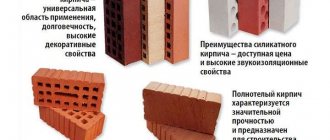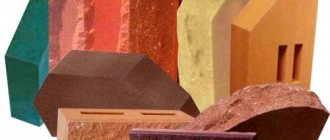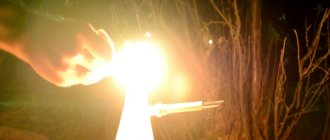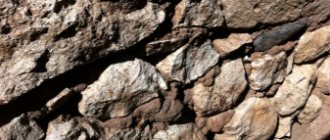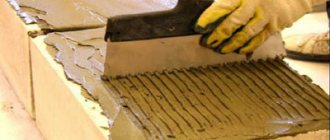Despite the rapid development of new technologies and improvements in home heating methods, the old proven brick stoves for wood-burning cottages still do not lose their relevance.
Wood burning stove
Indeed, often in houses remote from civilization or located in areas where there are power outages and gas supply is not expected at all, wood-burning brick stoves are the only possible means of heating the room.
Wood-burning stove for a summer cottage
But sometimes people deliberately choose brick stoves for their country house, despite all the benefits of civilization. After all, they help create that unique comfort, give the warmth and atmosphere of solitude that we all look for when going out of town.
We’ll talk about the advantages, design principles and features of laying a brick stove with your own hands today in this article.
Advantages of stove heating
Wood burning stoves heat up quickly and distribute heat over a long period of time. The brick emits radiant energy, which is good for health. A house where a stove is installed is always comfortable and warm. Thanks to draft, natural ventilation is created in the room. The designs often have a hob on which food can be prepared. In addition, such a stove can be used to dry clothes, shoes and food.
A combination oven is a device that has several functions. This includes a fireplace stove, a heating and cooking stove and a Russian stove.
The only significant drawback is poor heating of remote rooms. That is why they try to install the entire structure in the center of the house for uniform heat transfer. In large houses, it is advisable to install several stoves that have a combined chimney. The hob is usually installed towards the kitchen.
Heating equipment differs in appearance and design.
Usually the stove is installed between several adjacent rooms so that they all heat up evenly Source pechnoy.guru
Device and elements
The operating principle of this heating system is based on a long, winding chimney, which makes it possible to heat several floors using a single structure.
The Dutch oven consists of a firebox and a long winding chimney. The design also includes a blower and several doors. In total, the Dutch style uses several elements:
- Blower and blower door;
- Firebox and fire door;
- Soot collection chamber and cleaning door;
- Chimney;
- Gate valve;
Each element performs its role and allows the circular structure to achieve maximum power levels by distributing a small amount of smoke throughout the heating system in an even amount.
The design of the Dutch oven also requires compliance with certain rules to maintain fire safety and ensure comfortable operation.
Design example
Dutch oven
The design is one of the most popular. Some models are equipped with a hob and oven, which solves the problem of cooking, but the classic “Dutch” is used only for heating.
The duct-type firebox heats the walls perfectly. The smoke is discharged through a vertical channel, in which almost all of it burns. Although brick stoves for wood-burning homes are usually large in size, the same cannot be said about the Dutch stove, so it is optimally suited for comfortable heating of a private house - one or two floors. Outwardly, the Dutch woman resembles a column. The shape of the structure can be round, square or rectangular.
Advantages of a Dutch woman:
- After long breaks, you can start firing the stove at full power.
- A small structure can heat a house of 70 square meters. m.
- Economical. Low material consumption. The installation price is lower, as well as saving space.
- The design has thin walls, so it warms up quickly.
Classic “Dutch” stoves take up less space, but they are used only for heating the house Source ar.decoratex.biz
Disadvantages:
- The efficiency is no more than 40%.
- You should not forget about cleaning the stove from ash, as well as soot for normal draft.
- The most effective mode is smoldering. This design is often called a long-burning furnace.
- After heating, you need to close the view, otherwise the stove will quickly cool down.
This equipment can be used to heat small houses that have 2 floors or an attic floor.
Russian stove
It is large in size and multifunctional, and also has smoke channels and an open firebox. It is sometimes closed with a flap. The equipment may have a hob.
In addition to heating the room, this design allows you to cook food and dry clothes.
The efficiency is maximum 60%. In winter, the stove must not be allowed to cool down, so it should be fired regularly. If the structure cools down, condensation may occur. The brick becomes saturated with moisture, and upon subsequent cooling it freezes and cracks.
In summer, you can use the oven in summer mode for cooking. In this case, the smoke is directed directly into the chimney using a damper, and the body of the structure does not heat up.
Modern Russian stove with a stove bench in a wooden house Source yandex.ru
Advantages:
- With timely heating, a comfortable microclimate and temperature are created in the house.
- Multifunctional design.
- A brick stove for a summer house decorates the room.
Flaws:
- High installation cost due to the large volume of bricks.
- Due to the large weight and size, it is necessary to build a solid foundation.
- Low efficiency.
- The ducts and chimney must be cleaned regularly.
Such equipment is suitable for year-round use.
See also: Contacts of construction companies that offer installation services for fireplaces and stoves.
Swedish oven
The stove has a universal design and is designed primarily for efficient operation in small areas. The standard “Swedish” is equipped with an oven, hob, and niches for drying things. Some Swedes have a couch and a fireplace.
The principle of operation of a Swedish stove is approximately the same as that of a bell-type stove - combustion of flue gases occurs under the arch of the firebox.
Design advantages:
- The room heats up very quickly.
- Possibility of cooking both on the hob and in the oven.
- Almost complete combustion of fuel.
- Thanks to the design of the channels, the lower part of the equipment is heated, and, consequently, the floors are slightly heated.
- A heat exchanger can be installed in the design to heat water.
The Swedish brick stove has its own characteristics, but it copes well with heating the house Source mauro-gianvanni.ru
Cons:
- To prevent heat loss through the floor, it is necessary to install high-quality thermal insulation.
- For the installation of heated elements, fireclay bricks are used, which have a higher cost.
- Experts recommend leaving the stove always warm in winter. Firing a cold stove can lead to deterioration of the masonry.
Bell furnace
One of the modern designs is such a stove. The equipment heats up well and retains heat for a long time. The design does not have small winding channels, therefore, they are not so susceptible to soot settling.
The principle of operation of a bell-type furnace: smoke rises from the firebox, then remains there until it cools. And then it begins to descend along the walls of the chimney, thus heating it. Such designs are effective because they can have several caps.
Advantages:
- Low cost of material and installation. Simplicity of design.
- You can install a heat exchanger and a hob.
- Heats up quickly even after completely cooling.
- The gas view prevents reverse draft. This is why the oven cannot cool down when the damper is open.
Modern hand-made stoves provide the ability to heat several rooms in the house at once Source mauro-gianvanni.ru
Such a stove can have several hoods, and, therefore, it will be possible to heat 2 floors and several rooms. It is difficult to identify any shortcomings, which is why the bell-type model is popular among homeowners.
Video description
How to lay a small stove, watch the video:
Direct flow type
There is nothing particularly difficult about how to make a direct-flow furnace. But it is very important to strictly adhere to all requirements and be sure to choose a quality stone.
Used for heating small rooms. A strong foundation is needed. Design dimensions 51x64 cm (WxD).
The arrangement of the furnace is as follows:
- For the foundation, crushed stone is poured into a layer of up to 20 cm and filled with mortar. Each stage must be carefully aligned. You can lay the stone only after a few days.
- The depth of the structure is 2.5 stones, the width is 2. There is no blower chamber; instead, holes are drilled in the door.
- Only the 6th row will cover the door. The general procedure is very simple, you just need to observe the dressing.
- From the 8th row, the structure is narrowed using halves of ¾ pieces of stone. Firebox outlet 12.5x25 cm.
- The 9th row is laid with a whole brick, similar to the 7th.
Laying a direct-flow furnace Source blog-potolok.ru
- The next row is placed edge flush with the inner edge.
- Then again, flat (4 pcs. ¾ and 2 pcs. whole), narrowing the smoke channel.
- Next, the stones are edge-on, there is a brick in the middle of the channel, the structure rises 5 tiers.
All other channels are laid flat. On the last 2, the channel is narrowed in halves to dimensions of 12x12 cm. The valve and pipe are installed last.
See also: Catalog of companies that specialize in the installation of stoves and fireplaces, grill houses and gazebos.
For heating
Let's look at how to build a brick stove for heating. For example, let's take a stove 51cm x 90cm x 2m 38cm (WxDxH).
The following materials will be required:
- sand/clay/brick (18/9 buckets/390 pieces, red, solid);
- doors (cleaning and blowing doors);
- roll of waterproofing roofing felt (60cm x 1m);
- one valve and grid 40x25 cm;
- one pre-furnace steel sheet 70x50 cm.
Brick stove-fireplace for heating Source svoimirukami.lesstroy.net
The masonry process is as follows:
- The base protruding in the first row is laid. Be sure to check the horizontal level with a level. The hardest thing to work with is the corners. It is recommended to install template posts at the corners from bottom to top.
- Two stones with beveled edges are placed at the end.
- The air vent door is installed and secured.
- On the next 2 tiers an ash chamber is made.
- The fire chamber is laid out and a grate is installed.
- The firebox door is placed from the 7th to 8th tiers, beveled bricks are placed at the back (they improve the draft inside the stove).
- At 9 the firebox door is closed.
- The smoke exhaust and fuel chamber are placed from rows 10 to 16.
- The cleaning door is installed on the 17th row.
- Smoke circulation channels are made on 18-30 rows. The walls must be smooth; the inside of the walls must be rubbed with a wet rag.
- On the next two tiers, the roof of the furnace is made.
- The last 2 tiers are laid out for the chimney.
Laying a heating stove Source eurolain.ru
How to make a brick stove for your home with your own hands, if the room is small, is described above. The main thing is to adhere to all requirements and rules. Upon completion of the masonry, the structure must be left to dry. After seven days, a test fire is required.
Economical option
If your budget is limited and the room itself is small, then such a design will be a real salvation. There are many fairly simple designs for economical stoves. You can try making them yourself or order installation. But in any case, you need to understand how to lay a brick stove with your own hands. Even if you don’t do the masonry yourself, knowing how to build a stove will allow you to control all the work.
Heating stove Source i.ytimg.com
Is it possible to build long-burning brick stoves?
Every homeowner wants to install heating that does not require much labor. Arranging this in a long-burning wood-burning home stove made of brick is quite problematic. Industrial furnaces made of metal that operate on this principle produce carbon monoxide. A long burning mode can be arranged in a Russian or Dutch oven. But this method is not 100% effective. Therefore, it is recommended to install a standard brick stove, which retains heat for a long time.
Conclusion
A Dutch oven with a metal casing will be an excellent heating system for two-story country houses, to which gas pipes cannot be connected and a classic boiler heating system cannot be installed. Also, round Dutch ovens are an excellent choice for any agricultural buildings - they do not have enormous power, but are able to heat the room for fairly comfortable living.
The design of round Dutch ovens with a metal casing is the main advantage of these heating systems - despite the complexity of installation, anyone can lay a stove if they use the required order and prepare the solution correctly.
Of course, if you are not sure that you can correctly lay the stove, then it is better to seek the help of specialist stove-makers who will be able to install the entire structure correctly, and the stove will function as it should.
Basic masonry techniques
In production, heat-resistant and fire-resistant materials for the firebox, as well as hardened bricks, are used. It is not recommended to build a stove yourself. It is necessary to contact specialists for high-quality and safe masonry.
Specialists carry out work in compliance with all safety standards and regulations. For laying bricks, cement mortar is used, which is diluted with sand in a ratio of 1 to 3.
For binding material, many craftsmen use clay and sand.
Each row of bricks is laid out in a certain way to form a stove for a given project. Source pechki.net.ru
Required Tools
For easy and quick installation, you need to prepare in advance a certain list of tools that will be useful to you in the construction of the Dutch oven:
- Pickaxe or guillotine;
- Measuring tools: level, tape measure, square;
- A basin for diluting the solution;
- Bucket and shovel for convenience;
- Mason's trowel.
If you make a metal casing yourself, then you will also need tools to assemble it: metal scissors, rivets and a riveting device, or a welding machine.
What you need to purchase to build a stove
First you need to purchase masonry mortar and bricks. The amount of material will be calculated by a specialist. Do not forget about constructing a separate foundation for installing the furnace. The equipment will require cast iron elements: a door for the firebox, a blower (ash pan door), rings for the burner, a chimney valve, a grate and a hob.
In addition, it is necessary to purchase steel elements: a hot water tank and an oven. When building a structure, you will need strips made of metal of different widths and lengths. A corner made of metal of standard size 0.5 x 0.5 cm. Annealed steel wire with a diameter of 0.2 - 0.3 cm. A sheet of steel must be placed before the firebox.
Some designs may require roofing iron to cover the cooking chamber.
The required amount of material is calculated by a specialist based on the size and type of oven.
Long-burning wood-burning brick stoves for homes are built from fireclay and red bricks, clay and sand. To build the foundation you will need sand and cement, crushed stone, roofing felt, as well as boards for formwork.
Doors and gratings (grids) are mounted along the masonry of the main structure Source extracraft.ru
Video description
For a clear overview of laying and applying mortar, watch the video:
- Duplicate row, but the stones are laid flat.
- The brick is on edge, the walls are wiped with a wet rag.
- The brick is laid flat, and on the back side - on the edge.
- Next, the firebox is closed, 2 bricks should hang over the chamber (if the structure is planned to be used as a fireplace and the firebox is not covered), the flame will be directed to the middle of the structure.
- The stones are moved a little to the back side, they will support the door. Before laying the brick, wet strips of asbestos are laid to seal it. The panel cannot be placed on the mortar - cracks will appear due to the difference in thermal expansion.
- A pipe is formed to remove smoke. A smooth expansion is made towards the back. Stone is used for the base; light metal is used for everything else.
- A valve is installed, it is necessarily sealed with asbestos, first coated with a solution. This completes the construction of the structure.
Decorated stove for cooking and heating Source mainavi.ru
At the end, several tiers of the chimney are made, and a pipe is inserted into it. The brick (installed without mortar) and all debris are removed. The joint of the structure near the floor is closed for decoration with metal. The structure will dry completely after 1-2 weeks.
How to build a simpler type of oven if you don’t have the time, necessary materials or skills? Take advantage of the following structure, which can be erected in just a few hours. It has the simplest operating principle.
Fuel is placed below, which burns there, and where it settles. The draft is created by temperature changes. This design is characterized by a minimal amount of smoke and almost complete combustion of fuel. For this option, two half stones and 20 whole bricks are enough. There are five rows in the stove, the stones are tied together with mortar, but you can lay out the stove without using it - it will be a temporary structure.
Brick pyrolysis stove
Such heating equipment can be classified as long-burning. Solid fuel burns without oxygen. With the help of wood, volatile gases are saturated, and then burned at a temperature of more than 450 ° C, and they are mixed with the remaining air in the 2nd chamber.
This design has a high efficiency, which can reach up to 95%.
You can install the equipment in a country house, garage or small country house. The pyrolysis furnace consumes little fuel at maximum operation. All solid material burns almost completely. Soot practically does not settle, since coals and gas are burned.
All pyrolysis models work on this principle, but different designs differ in characteristics and appearance.
A pyrolysis oven may not be very different from classic brick ovens Source stop-othod.ru
Materials and their quantity
| Name | Qty |
| Blower door | 1 piece each |
| Cleanout doors | 2 pieces |
| Fireclay brick | 50-100 pieces |
| Regular red brick | 200-500 pieces |
| Gate valves/gates | 2 pieces |
| Grate | 1 piece |
| Clay | 90 kilograms |
| Sand | Half a cube |
All doors can be purchased in specialized stores or at a building materials warehouse in your city. Many people order designer doors from local craftsmen so that their stove can become a design element of the room.
Expert opinion
Pavel Kruglov
Stove maker with 25 years of experience
If you decide to install a metal casing on the structure and at the same time make it yourself, then in addition to the above materials you will need several sheets of galvanized or roofing metal. Their number depends on the height of the stove and its width; usually 2-3 sheets are enough to make an iron case for a Dutch oven 3 meters high.
How does a brick wood stove work?
Brick stoves collect heat and gradually distribute heat throughout the room. A small house is heated from 15 to 24 hours. Smoke escapes through the chimney due to natural draft. The room in which heating equipment is installed should be regularly ventilated. The valve on the main pipe closes to stop the draft.
It is optimal to use dry firewood for the firebox. It is necessary to clean the ash in the receiving compartment. There are usually no problems when using the equipment.
It is not recommended to use various household waste or building materials that are harmful to health as fuel.
Brick structures have some disadvantages:
- Cleaning the chimney about 2 times a year;
- You need to add firewood manually;
It is necessary to build a furnace only from high-quality materials that meet all standards. Otherwise, the equipment may not heat the room well or the smell of smoke may appear in the house.
If the stove is being built from 450 bricks or more, then it is necessary to build a foundation. Heating equipment can be installed on the base of the house if it is made in the form of a whole slab. A separate foundation is arranged without reference to the base.
Basically, the foundation for a brick kiln is made according to a standard scheme Source nastroike.com
According to the house plan, a place is selected for installing the heating structure during the construction of the house. In a house that is already in use, the arrangement of the equipment is designed so that the chimney is located between the floor beams. It should be at a distance of 1 meter from the rafters.
The chimney pipe must be at least 0.5 m higher than the roof. The closer the pipe is to the ridge, the higher it should be.
Experience of FORUMHOUSE craftsmen
Among the participants of our portal, mainly outdoor modifications of the Russian stove, intended for preparing pickles in the fresh air or in closed complexes, are popular. The use of a classic design as a heating unit is much less common: its style cannot fit into every interior, its execution is complex, its efficiency is low, and it takes up more space than modern solid fuel units. But the taste of dishes cooked in such an oven is superior compared to derivatives of gas or electric ovens and iron grills. Because of this, it is outdoor stoves or complexes that have become most widespread.
Briefly about the main thing
A brick heating and cooking stove, installed by professionals, may additionally have a fireplace section, a heated bench, a chamber for drying vegetables and other useful compartments. Today, many projects of such structures for private houses have been created. Moreover, they have a T-shape, wide or narrow design.
The stove is selected depending on the area of the room and the entire residential building. Its location is also taken into account. After all, it can be located at the corner, in the middle or against the wall of the room.
One of the interesting options is the Swedish stove-fireplace, designed by Ryazankin. This is a small but functional design. During the laying of each row, from 5 to 36 bricks are used.
Ratings 0
Operating principle
A deck oven has high efficiency with minimal fuel consumption.
The operation of a deck oven differs from a classic one. The main property of such products is high efficiency with minimal fuel consumption. Burnout is distributed evenly. Thanks to the air entering through the firebox door, sufficient oxidation of the firewood occurs, increasing the quality of its combustion and the level of heat release.
The loading of firewood is carried out at the lower level in the loading chamber. Then the combustion process occurs in the working area. Gases are removed from the upper level and heat exchange occurs.
To maintain high temperatures (about 400°C), the furnace body is made of polished stainless steel. The lining is made of fireclay bricks or other fire-resistant material.

